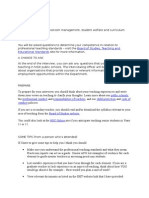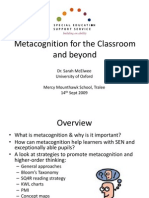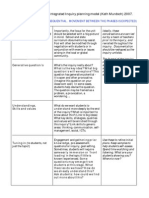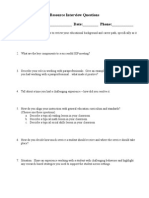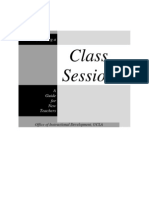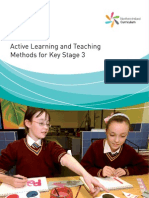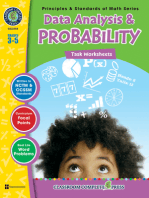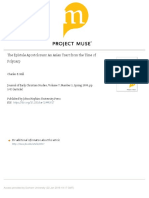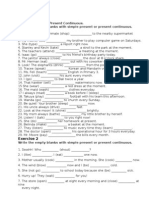SkillfulTeacher p204-211
SkillfulTeacher p204-211
Uploaded by
Diane PriceCopyright:
Available Formats
SkillfulTeacher p204-211
SkillfulTeacher p204-211
Uploaded by
Diane PriceOriginal Description:
Original Title
Copyright
Available Formats
Share this document
Did you find this document useful?
Is this content inappropriate?
Copyright:
Available Formats
SkillfulTeacher p204-211
SkillfulTeacher p204-211
Uploaded by
Diane PriceCopyright:
Available Formats
204
The Skillful Teacher
something to address them; gather preassessment
data to plan 'where and how to begin where the
All children need to be engaged in conver~
sation with higher-level thinking questions.
learners are in relation to our objectives. Next, we
discussed instructional moves to consider when pre-
This is especially important for children
senting information: being intentional and using a
variety of explanatory devices, monitoring your
speech and language patterns to match to the
group and prevent confusion; being explicit and
not leaving to chance that students understand the
intention of your cues, the focus of your questions,
the necessary or critical steps in directions, the
meaning behind your references; making cognitive
connections for or wi.th students by showing or
exploring how new knowledge is like something stu-
who are low in academic proficiency. Students who are three or four grade levels
behind in literacy skills are still perfectly
capable of higher-level thinking: inference.>'
analysis, connection making. Furthermore,
teachers need to engage them in this kind
of thinking if they want to keep these children engaged in school.
Questions should be planned when we are
planning lessons, and planned with more
specificity and detail than many of us are
dents already know; providing cognitive transitions
used to doing. Don't just plan the activities
between ideas; signaling shifts; and foreshadowing.
To monitor student understanding, we discussed
the importance of checking to ensure all students
and topics for discussion and then wing it
on what questions to ask as we go.
Students should be taught to ask questions.
are understanding, unscrambling confusion when
it arises, and getting students to make their thinking visible. And the final concern is in protecting
time for summarizing. Each of these is a functional
aspect of the Clarity area of performance.
Purposes of Questions
Questions are tools for accomplishing tasks. It is
the tasks that matter, and being deliberate about
what we are trying to accomplish with the question and having the repertoire of tools for accom-
Questioning
Questioning is done in classrooms for many pur-
plishing them. Question asking is not an
independent and self-contained skill. A question
areas of performance in teaching. There are four
is a tool, and not the only one, for stimulating
many important student cognitions: framing, acti-
main points about questioning
vating, connection making, analyzing, extending,
poses. We could say that it crosses nearly all the
that we want to
highlight in this chapter. Each has large implications for practice:
applying, inferring, conjuring implications, checking for understanding, identifying points of confusion, implementing
a model of teaching,
Questioning is not a unitary skill; it is an
entire toolbox, and the tools selected should
summarizing, and other tasks. Rather than trying
be matched to the instructional purpose.
Figure 9.7 shows a variety of purposes for
asking questions. Table 9.4 includes sample
questions designed for each purpose.
to develop questioning generically as some kind
of skill, it is more productive to focus on what
mental act we want to generate in students at a
given moment and what move (perhaps a question) we will make to provoke it.
205
Clarity
Figure 9.7. Purposes of Questions
Assess Current
Kno"vi,tledge and Skills
Check for Understanding
-<l
Pinpoint
SS~Sr
Confusion
~6~
"'/~
G'(~
~c,~~ Extend
Invite Self-Assessment
;.q~-1I1. Make
1ttG'
-=:-_
~6'\ Focus Thinking
Surface Misconceptions
Instructional
Decisions
Thinking
Foreshadow
PURPOSES
.b.-9.
OF
~ ~~
6~~ ~~
6\~ \~O~ Maintain
~~~~
~~~
QUESTIONS
~1I_01l?0
~v/0l/. /f~
Attention
<y~~ Control Behavior
Boost Confidence
'v<y~
Motivate
Students
Stimulate
Promote Reflection
0-11 G' <'0
Curiosity
(~-1IG:G'-1I/"v.
and Integration
'.</G'~1l?,
~ -<l~
Connect to Student Questions
Connect to Student
~-11)'~
Experience
SOUTce: Adapted from Bellon, Bellon, and Blank (1992).
Higher-Level Thinking Questions
ing is inherently more interesting and it causes cognitive processing and organization of information
Here are some interesting statistics about teacher
that builds more elaborate mental structures. The
questions. Quite consistently studies show that about
60 percent of questions are recall or factual questions. The figure can rise to 80 percent recall in some
classrooms (Cotton, 2000). Only 20 percent are higher level, and the remaining 20 percent are procedur-
point that matters is that all students should be
brought to high levels of thinking with academic
material through an appropriate balance of higherand lower-levelquestions. To stretch students, teachers have to make sure all the students are invited
al. These are not good statistics for preparing
students adequately for a twenty-first-century world.
equally into the thinking club, not just some.
Students who get instruction without higher-
Research on questioning does not say simply
that the more high-level ques.tions, the better. It
order questions score in the fiftieth percentile on
tests compared to the seventy-fifth percentile if the
does not say that low-level questions are useless:
same students engage in lessons where there are
The popular belief that lower level questions
many higher-order questions (Gall and others,
1978). The reason for this is that higher-order think-
are less effective ... has not been upheld.
Achievement is related to the use of a variety of
Table 9.4. Sample Questions
Example
Purpose of Questions
Assessing learning
Assess Current Knowledge and Skills
"Why do some objects float in water and others sink?"
Check for Understanding
"Can you tell me in your own words how photosynthesis works?"
Pinpoint Confusions
"What did you do after you entered the data?"
Surface Misconceptions
"Why do you thinkwe
Invite Self-Assessment
"Which ones do you know well, and which ones do you need to practice
tomorrow?"
Make Instructional Decisions
"Do we need more time on this?"
have winter and summer?"
Instructing
Frame Big Ideas
"What makes humans human?"
Extend Thinking
"Is this similar or different from the situation in Palestine?"
Deepen Thinking
"Go inside that now and tell me why that position might have-made sense
from his point of view."
Foreshadow
"Based on what we've explored today, why do you think the colonists decided to stay?"
Promote Transfer
"So how could you use this information about evaporation in your everyday
practical life?"
Invite Summarizing
"What do you think were the most important points made in the discussion
so far?"
Managing the learning
Environment
Boost Confidence
"How would you do it, Tim?" [Tim is not confident of his math ability, but
Mrs. Johnson has heard him propose a novel solution in his group. She
wants him to present it to the class, knowing it will be appreciated by them
and be a validating experience for Tim.]
Control Behavior
"How would you do it, Tim?" [Tim is starting to distract Millie, and Mrs.
Maintain Attention
"How would you do it, Tim?" [Tim's attention is wandering and Mrs. Johnson
startles him back into focus.]
Johnson moves toward them while asking a question to get him engaged.]
Promoting Cognitive and Emotional Engagement
Motivate Students
"What product do you most want to design an ad program for?"
Stimulate Curiosity
"What do you know about voting and elections in this country?"
Promote Active Reflection and Integration
"What are three things you've learned, two questions you have, and one
Connection to Students' Own Questions
About Deeper Meaning
"What do you think the most important things are about having a family?"
Connect to Student Experience
"In 'Stone Soup: does the villagers' reaction to the soldiers remind you of
anything you've experienced in the neighborhood?"
thing you don't understand yet?"
"What do you think the crime movie The Negotiator might have to do with
international affairs?"
Research for Better Teaching, Inc. One Acton Place, Acton, MA 01720 (978)263-9449
www.RBTeach.com
Clarity
Figure 9.8 Map of Pedagogical Knowledge
KEY CONCEPTS
Areas of Performance
Repertoire
Matching
Curriculum
Planning
Planning
Learning
Experiences
Assessment
Personal
Relationship Building
Class Climate
Expectations
Instructional
Strategies
Principles of
Learning
Clarity
Space
Models of
Teaching
Time
Attention
Routine
Momentum
Discipline
Foundation of Essential Beliefs
Research
for Better Teaching,
Inc. One Acton Place, Acton, MA 01720 (978)263-9449 www.RBTeach.com
questions designed to accomplish specific pur-
person does not know or understand [Bellon,
poses. For example, a pattern of factual ques-
Bellon, and Blank, 1992, pp. 315-316].
tions, student responses, and teacher feedback
has been found to be the most functional
mechanism for student achievement in basic
skills....
[Furthermore] successful responding
to lower level questions is a prerequisite for
higher level learning. Students need a firm base
of factual knowledge when they are engaged in
higher level thinking activities. It is impossible
to summarize or evaluate information that a
At the conclusion of an exhaustive review of
the research on questioning, Bellon, Bellon, and
Blank (1992) concluded that teachers should plan
questions and write them down in advance as part of
the planning process to accomplish the learning
objective of the lesson. If the objective of the lesson
callsfor analysisand application of information, they
may need to ask quite a few recall questions first.
207
208
The Skillful Teacher
As always in skillful teaching, the balance of
higher- to lower-level questions must be a match to
the situation. But overall, there should be a high portion of higher-level questions for all students. Here
is a summary of the research findings on higher- and
lower-cognitive questions (Cotton, 1988, p. 5):
In most classes above the primary grades, a
combination of higher- and lower-cognitive
questions is superior to the exclusive use of
and wait time is greater than an increase in
either of these variables.by itself. Indeed,
those who have examined the relationship
between these factors tell us that, in a sense,
they cause one another.
Redirection and probing are positively
related to achievement when they are
explicitly focused on the clarity, accuracy,
plausibility, and so on of student
responses.
one or the other.
Students whom teachers perceive as slow or
poor learners are asked fewer higher-cognitive questions than students perceived as
most capable learners.
Increasing the use of higher-cognitive
questions (to considerably above the 20 percent incidence noted in most classes) pro-
Bloom's Taxonomy
All students need to be invited and supported to do
higher-level thinking, no matter what their literacy
level. To do this requires a clear framework for
understanding
what higher-level thinking is. Ben-
duces superior learning gains for students
jamin Bloom and his colleagues (1956) created the
original framework for this understanding. Bloom
and Krathwohl originally listed these levels for cog-
above the primary grades and particularly
nition:
for secondary students.
For older students, increases in the use of
higher-cognitive questions (to 50 percent or
more) are positively related to increases in
on-task behavior, length of student
responses, the number of relevant contributions volunteered by students, the number
of student-to-student interactions, student
Recall
Comprehension
Analysis
Application
Evaluation
Synthesis
Many grids, like the one in Table 9.5, illustrate the different levels of thinking with specific
use of complete sentences, speculative
thinking on the part of students, and rele-
question stems and lists of verbs found at different
vant questions posed by students.
cognitive levels.
For older students, increases in the use of
higher-cognitive questions (to 50 percent or
more) are positively related to increased
teacher expectations about children's abilities, particularly the abilities of students
whom teachers habitually regarded as slow
learners.
The degree of improvement resulting from
increases in both higher-cognitive questions
Anderson and Krathwohl (2001) updated the
original Bloom framework by adding the four kinds
of knowledge to be learned to the picture: factual
knowledge, conceptual knowledge, procedural
knowledge, and meta-cognitive knowledge (Table
9.6). In addition, they redefined Bloom's "synthesis category" as "creating," by which they mean
"putting elements together to form a coherent or
functional whole: reorganizing elements into a new
Table 9.5. Thinking Skills Model Categories
Category
Examples of Trigger Questions
Knowledge
Define the word
Define, repeat, identify, what, label, when,
list, who, name
What is a
Label the following
Identify the
in this
Who did
Organizing
Compare the
before and after
Contrast the
to the
Classify
Order
Differentiate between
Applying
Key Words
and
by
Compare, differentiate, contrast, order,
classify, distinguish, relate
by
How is
an example of
How is
related to
Why is
significant7
Apply, demonstrate, calculate, complete,
illustrate, show, solve, examine, modify,
relate, change, classify, experiment, discover,
Predict what would happen if
. Explain.
dramatize, sketch
Choose the best statements that
applyto
_
Identify the results of
Tell how much change there would be
when
_
Analyzing
What are the basic elements (ingredients)
in a
7
What is/are the functions(s) of
Inventory the parts of
Categorize the
Sortthe
Generating
_
of
What is the order of steps in
Hypothesize what will happen if
Predict what would be true if
Integrating
Deduce, anticipate, predict what if, infer,
apply, speculate, conclude
Conclude what the result will be if
What if
instead of
Subdivide, categorize, break down, sort,
separate
had happened
7
What would you predict/infer from
What ideas can you add to
How would you create/design a new
What might happen if you combined
What solutions would you suggest for
Evaluating
Combine, integrate, modify, create, design,
invent, compose, theorize, develop, devise,
originate, revise, synthesize, conceive, project, hypothesize
What you would do if
happened? Why7
Judge what would be the best way to solve
the problem of
_
Why did you select that solution?
?
Evaluate, argue, judge, recommend, assess,
debate, appraise, critique, defend
Evaluate whether you would,
or
. Why?
SOUTee: Reprinted with permission from Chris A. Carem and Patsy B. Davis, Kappa Delta Pi Record; Fall 2005, Kappa Delta Pi, International Honor Society in Education.
210
Table 9.6.
The Skillful Teacher
Bloom's Taxonomy Updated
Know/edge
Dimensions:
The Kind of Know/edge
to Be Learned
Procedural
Knowledge:
Meta-Cognitive
Knowledge:
Basic elements that
The interrelationships
students must know to between the basic
be acquainted with a
elements within a
discipline or solve a
larger structure that
enable them to
problem within it
function together
How to do
something: methods
of inquiry, criteria for
using skills,
algorithms, techniques, and methods
Knowledge of
cognition in general as
well as awareness of
one's own cognition
Remember
List, recall, recognize
Describe
Tabulate
Identify appropriate use
Understand
Summarize
Interpret
Predict
Execute
Apply
Classify
Experiment
Calculate
Construct
Analyze
Order
Explain
Differentiate
Achieve
Evaluate
Rank
Assess
Conclude
Action
Create
Combine
Plan
Compose
Actualize
Factual
Knowledge:
Cognitive
Processes
Conceptual
Knowledge:
SOUTce: Updated from Anderson and Krathwohl (2001).
pattern or structure through generating, planning
or producing." They define the other basic cognitive processes as follows. (The verbs at the core of
each type of question are from Fisher, 2005, p. 4).
Remembering (the old "recall" category):
Retrieving, recognizing, and recalling relevant knowledge from long-term memory.
Understanding (the old "comprehension"
category).
Constructing meaning from oral, written,
and graphic messagesthrough interpreting,
exemplifying, classifying, summarizing,
inferring, comparing, and explaining.
Applying:
Carrying out or using a procedure through
executing or implementing.
Analyzing:
Breaking material into constituent parts,
determining how the parts relate to one
another and to an overall structure or pur-
pose through differentiating, organizing,
and attributing.
Evaluating:
Making judgments based on criteria and
standards through checking and critiquing.
Creating:
Putting elements together to form a coherent or functional whole: reorganizing elements into a new pattern or structure
through generating, planning or producing
[Reprinted with permission from Dianna
Fisher,2005).
Tools like this are useful for planning lessons. The
implication of the research on questioning for lesson planning is that we must be deliberate about
our questions and plan a route so we use them to
get all our students into higher levels of thinking.
We also have to prepare ourselves for how students
respond to the questions.
You might also like
- Hacking Learning Centers in Grades 6-12: How to Design Small-Group Instruction to Foster Active Learning, Shared Leadership, and Student AccountabilityFrom EverandHacking Learning Centers in Grades 6-12: How to Design Small-Group Instruction to Foster Active Learning, Shared Leadership, and Student AccountabilityRating: 5 out of 5 stars5/5 (4)
- Hacking Questions: 11 Answers That Create a Culture of Inquiry in Your ClassroomFrom EverandHacking Questions: 11 Answers That Create a Culture of Inquiry in Your ClassroomRating: 5 out of 5 stars5/5 (4)
- The Artof Questioning 2013Document48 pagesThe Artof Questioning 2013Jennie KimNo ratings yet
- Notes On IntviewDocument41 pagesNotes On IntviewTibz100% (1)
- Upgrading Critical Thinking SkillsDocument9 pagesUpgrading Critical Thinking SkillsEgoku SarkodesNo ratings yet
- Creating Motivating and Engaging Learning Environments 4Document6 pagesCreating Motivating and Engaging Learning Environments 4api-393590191No ratings yet
- Ass Classroominstructionthatworksgroup MorazanoDocument37 pagesAss Classroominstructionthatworksgroup MorazanoYasmeen JafferNo ratings yet
- What Are Big Ideas?: Teaching For Understanding Making Our Courses More EffectiveDocument36 pagesWhat Are Big Ideas?: Teaching For Understanding Making Our Courses More EffectiveMam MamcomNo ratings yet
- Metacognition Workshop S McAlwee 09Document55 pagesMetacognition Workshop S McAlwee 09EsraRamosNo ratings yet
- Socratic Questioning in ActionDocument62 pagesSocratic Questioning in ActionMummy Masayu100% (3)
- WebQuest ESL EFL StudentsDocument17 pagesWebQuest ESL EFL Studentssusytutty102807No ratings yet
- Pueblos - The Art of QuestioningDocument67 pagesPueblos - The Art of QuestioningPrinciple 1No ratings yet
- Answer: Uestion 1Document13 pagesAnswer: Uestion 1payeah montuyaNo ratings yet
- Case-Based Learning - Centre For Teaching and LearningDocument3 pagesCase-Based Learning - Centre For Teaching and LearningKim SolimanNo ratings yet
- Kath Inquiry PDFDocument2 pagesKath Inquiry PDFSathyanand SwaminathanNo ratings yet
- Formative Assessment AssignmentDocument5 pagesFormative Assessment Assignmentapi-576294396No ratings yet
- Higher Order Thinking Skills in The Classroom Skills: Bloom's TaxonomyDocument30 pagesHigher Order Thinking Skills in The Classroom Skills: Bloom's TaxonomyAhmad JawotoNo ratings yet
- John Tomsett rED 10-09-16Document70 pagesJohn Tomsett rED 10-09-16John TomsettNo ratings yet
- Showcasing Interactive Lecturing MethodsDocument3 pagesShowcasing Interactive Lecturing Methodscarolina orlandoNo ratings yet
- Why Teach Higher Higher Order Thinking SkillsDocument4 pagesWhy Teach Higher Higher Order Thinking SkillschandrikaNo ratings yet
- EDIM 508 Unit 3 Summary Posting Information Overload: The Need For The Synthesizing MindDocument3 pagesEDIM 508 Unit 3 Summary Posting Information Overload: The Need For The Synthesizing MindktitraceNo ratings yet
- Balanced Mathematics: What Is It?Document22 pagesBalanced Mathematics: What Is It?Piper Garner RiddleNo ratings yet
- What Is Higher Order Thinking Skills HOTSDocument5 pagesWhat Is Higher Order Thinking Skills HOTSshadoworacleNo ratings yet
- Thesis About Teaching MethodsDocument5 pagesThesis About Teaching Methodsafktgmqaouoixx100% (2)
- Resource Interview Questions Name: - Date: - PhoneDocument2 pagesResource Interview Questions Name: - Date: - Phoneapi-277207398No ratings yet
- Stem DTLDocument28 pagesStem DTLAravinda A KumarNo ratings yet
- Quantitative and Qualitative Research: Based On Slides by DR Terry MaguireDocument39 pagesQuantitative and Qualitative Research: Based On Slides by DR Terry MaguireJohn O'NeillNo ratings yet
- Art of QuestioningDocument44 pagesArt of QuestioningDominic NoblezaNo ratings yet
- Class Session: Planning ADocument13 pagesClass Session: Planning AJ. BarreraNo ratings yet
- Art of Questioning PDFDocument44 pagesArt of Questioning PDFDominic NoblezaNo ratings yet
- 4 Strategies of AfLDocument13 pages4 Strategies of AfLSadiaNo ratings yet
- Unit III Lesson 5Document5 pagesUnit III Lesson 5sani biNo ratings yet
- Asking Effective QuestionsDocument8 pagesAsking Effective Questionsjrogenski9000No ratings yet
- B.Ed Research ProjectDocument13 pagesB.Ed Research ProjectIfra Akhlaq0% (1)
- Methods of Research Chapter 10 Action ResearchDocument22 pagesMethods of Research Chapter 10 Action ResearchNhil Cabillon Quieta100% (1)
- Course Name - Instructional Techniques For Elementary and Middle School Classroom Course Code - EDU 5270 Instructor - Dr. Amanda NugentDocument6 pagesCourse Name - Instructional Techniques For Elementary and Middle School Classroom Course Code - EDU 5270 Instructor - Dr. Amanda NugentSneha MishraNo ratings yet
- Stats and Probability Unit UbdDocument54 pagesStats and Probability Unit Ubdapi-314438906100% (1)
- Dissertation On Motivation of StudentsDocument7 pagesDissertation On Motivation of StudentsHelpWithYourPaperLittleRock100% (1)
- Here Are Seven Effective Strategies For Teaching Elementary MathDocument13 pagesHere Are Seven Effective Strategies For Teaching Elementary MathAdonys Dela RosaNo ratings yet
- Steps For Inquiry and ProblemDocument8 pagesSteps For Inquiry and Problemtarekegn balangoNo ratings yet
- Problem Based Learning and Thinking Based LearningDocument20 pagesProblem Based Learning and Thinking Based LearningGorgeous X100% (1)
- Upside Down TeachingDocument10 pagesUpside Down Teachingapi-306029279100% (1)
- Tips For Better CLE PresentationsDocument2 pagesTips For Better CLE PresentationsaeuaNo ratings yet
- Chapter I FinalDocument47 pagesChapter I FinalGerland Gregorio EsmedinaNo ratings yet
- Beyond Understanding, Teach For Transfer: Name: Pastidio, Vivian S. Beed 4 C4Document3 pagesBeyond Understanding, Teach For Transfer: Name: Pastidio, Vivian S. Beed 4 C4asdNo ratings yet
- Teaching Methods and Strategies Problem Solving MethodDocument17 pagesTeaching Methods and Strategies Problem Solving MethodSHEFALI SINGHNo ratings yet
- What Are Essential Questions - The Second PrincipleDocument7 pagesWhat Are Essential Questions - The Second PrincipleDavid BumphisNo ratings yet
- Higher Order Thinking Skill NotesDocument3 pagesHigher Order Thinking Skill NotesHuiping LuNo ratings yet
- Solo TaxonomyDocument27 pagesSolo TaxonomyFaizatun Nazirah100% (4)
- Unit 05Document27 pagesUnit 05Tanzeela BashirNo ratings yet
- Question & Review:: Higher Order Questions GamesDocument25 pagesQuestion & Review:: Higher Order Questions GamesbeemitsuNo ratings yet
- Assignment EDU406.Docx123Document9 pagesAssignment EDU406.Docx123Tasswar HussainNo ratings yet
- A Kid Can Say!Document6 pagesA Kid Can Say!api-255505576No ratings yet
- Case Study MR Roth DardenDocument4 pagesCase Study MR Roth Dardenapi-515615857No ratings yet
- Designing Effective Classroom Learning ActivitiesDocument3 pagesDesigning Effective Classroom Learning ActivitiesHoney HonNo ratings yet
- Active LearningDocument84 pagesActive Learningolijayp100% (3)
- Teach Like Nobody's Watching: The essential guide to effective and efficient teachingFrom EverandTeach Like Nobody's Watching: The essential guide to effective and efficient teachingNo ratings yet
- British Council - Unit 1Document2 pagesBritish Council - Unit 1Prof. Cesar PinheiroNo ratings yet
- Week5 - Cja484 Global Perspectives Assessment 2Document9 pagesWeek5 - Cja484 Global Perspectives Assessment 2katina2873_16621225100% (1)
- DRK ChmpsDocument119 pagesDRK Chmpssteve918r8828100% (3)
- The Curse of Surya - Dev PrasadDocument1,006 pagesThe Curse of Surya - Dev PrasadAnkur Goel50% (2)
- Ncert Notes Class 9 Science Chapter1Document8 pagesNcert Notes Class 9 Science Chapter1ng_nirmalNo ratings yet
- MTD (01 To 12 Nov'23) Super Strength Sales Volume ReportDocument3 pagesMTD (01 To 12 Nov'23) Super Strength Sales Volume ReportabjnlinkNo ratings yet
- Kufr Bit Taghut SimpleDocument7 pagesKufr Bit Taghut SimpleSadiya SwalehNo ratings yet
- Total Quality Management Frameworks: A Comparative Analysis in Construction CompaniesDocument6 pagesTotal Quality Management Frameworks: A Comparative Analysis in Construction CompaniesInternational Journal of Innovative Science and Research TechnologyNo ratings yet
- 1st Quarter Tos UcspDocument2 pages1st Quarter Tos UcspNorven DulaugonNo ratings yet
- Systemverilog NotesDocument29 pagesSystemverilog NotesRavi BellubbiNo ratings yet
- Power System Harmonics Research: A Survey: G. K. SinghDocument22 pagesPower System Harmonics Research: A Survey: G. K. Singhguddu guptaNo ratings yet
- 50 Year and COVID-19Document39 pages50 Year and COVID-19Pretty SweetNo ratings yet
- Epistula Apostolorum by HillsDocument55 pagesEpistula Apostolorum by Hills321876No ratings yet
- Seminars - Course Documents - English Land Law 18-19Document18 pagesSeminars - Course Documents - English Land Law 18-19Emanuela Alexandra SavinNo ratings yet
- Intellectual Property and Art British English TeacherDocument13 pagesIntellectual Property and Art British English TeachertutormarieeveNo ratings yet
- CH7 Solved Examples On 2D Plane Solids - v2-1Document17 pagesCH7 Solved Examples On 2D Plane Solids - v2-1heshamNo ratings yet
- Between Romanticism and Modernism Four Studies in the Music of the Later Nineteenth Century Carl Dahlhaus all chapter instant downloadDocument40 pagesBetween Romanticism and Modernism Four Studies in the Music of the Later Nineteenth Century Carl Dahlhaus all chapter instant downloadhattomischg0100% (3)
- CHAPTER 24, 25, 26, 27, 28, 35, 36, 37, 38, 39, 40, 41, 42, and 43Document93 pagesCHAPTER 24, 25, 26, 27, 28, 35, 36, 37, 38, 39, 40, 41, 42, and 43chip chipsNo ratings yet
- 21ST CenturyDocument13 pages21ST CenturyMiah CanariaNo ratings yet
- Vector-Calculus Class Note Vector-Calculus Class NoteDocument47 pagesVector-Calculus Class Note Vector-Calculus Class NoteSuraj Gautam100% (1)
- RewindDocument5 pagesRewindssumampong5No ratings yet
- FSC Physics Chapter No. 2 (Theory Notes)Document26 pagesFSC Physics Chapter No. 2 (Theory Notes)Muhammmad UmairNo ratings yet
- Simple Present or Present Continuos Exercise 1 and 2Document2 pagesSimple Present or Present Continuos Exercise 1 and 2Veronica Tandra100% (10)
- 2 Benefit and Advantage of AgileDocument19 pages2 Benefit and Advantage of AgileRelaxation TvNo ratings yet
- Probabilistic Monitoring of Project Performance Using SS-CurvesDocument7 pagesProbabilistic Monitoring of Project Performance Using SS-CurvesFabricioNo ratings yet
- Comprehensive IncomeDocument9 pagesComprehensive IncomeJesiah PascualNo ratings yet
- Health Psychology FrenchDocument10 pagesHealth Psychology FrenchLucia VieiraNo ratings yet
- Paediatric Antibiotic TeddyDocument1 pagePaediatric Antibiotic Teddyayu fitrianiNo ratings yet
- CÂU ƯỚC MUỐN VÀ GIẢ ĐỊNHDocument4 pagesCÂU ƯỚC MUỐN VÀ GIẢ ĐỊNHVu MyhaNo ratings yet
- Emp News (Eng)Document24 pagesEmp News (Eng)JP EDSNo ratings yet



